The AMD Radeon R9 Fury X Review: Aiming For the Top
by Ryan Smith on July 2, 2015 11:15 AM ESTFiji’s Architecture: The Grandest of GCN 1.2
We’ll start off our in-depth look at the R9 Fury X with a look at the Fiji GPU underneath.
Like the Hawaii GPU before it, from a release standpoint Fiji is not really the pathfinder chip for its architecture, but rather it’s the largest version of it. Fiji itself is based on what we unofficially call Graphics Core Next 1.2 (aka GEN3), and ignoring HBM for the moment, Fiji incorporates a few smaller changes but otherwise remaining nearly identical to the previous GCN 1.2 chips. The pathfinder for GCN 1.2 in turn was Tonga, which was released back in September of 2014 as the Radeon R9 285.
So what does GCN 1.2 bring to the table over Hawaii and the other GCN 1.1 chips? Certainly the most well-known and marquee GCN 1.2 feature is AMD’s latest generation delta color compression technology. Tied in to Fiji’s ROPs, delta color compression augments AMD’s existing color compression capabilities with additional compression modes that are based around the patterns of pixels within a tile and the differences between them (i.e. the delta), increasing how frequently and by how much frame buffers (and RTs) can be compressed.
Frame buffer operations are among the most bandwidth intensive in a GPU – it’s a lot of pixels that need to be resolved and written to a buffer – so reducing the amount of memory bandwidth these operations draw on can significantly increase the effective memory bandwidth of a GPU. In AMD’s case, GCN 1.2’s delta color compression improvements are designed to deliver up to a 40% increase in memory bandwidth efficiency, with individual tiles being compressible at up to an 8:1 ratio. Overall, while the lossless nature of this compression means that the exact amount of compression taking place changes frame by frame, tile by tile, it is at the end of the day one of the most significant improvements to GCN 1.2. For Radeon R9 285 it allowed AMD to deliver similar memory performance on a 256-bit memory bus (33% smaller than R9 280’s), and for Fiji it goes hand-in-hand with HBM to give Fiji an immense amount of effective memory bandwidth to play with.
Moving on, AMD has also made some changes under the hood at the ALU/shader level for GCN 1.2. Many of these changes are primarily for AMD’s Carrizo APU, where task scheduling improvements go hand-in-hand with the AMD’s Heterogeneous System Architecture initiative and deliver improvements to allow the CPU and GPU to more easily deliver work to each other. Similarly, 16-bit instructions are intended to save on power consumption in mobile devices that use lower precision math for basic rendering.
More applicable to Fiji and its derivatives are the improvements to data-parallel processing. GCN 1.2 now has the ability for data to be shared between SIMD lanes in a limited fashion, beyond existing swizzling and other data organizations methods. This is one of those low-level tweaks I’m actually a bit surprised AMD even mentioned (though I’m glad they did) as it’s a little tweak that’s going to be very algorithm specific. For non-programmers there’s not much to see, but for programmers – particularly OpenCL programmers – this will enable newer, more efficient algorithms where when the nature of the work requires working with data in adjacent lanes.
But for gamers, perhaps the most significant architectural improvement to GCN 1.2 and thereby Fiji are the changes made to tessellation and geometry processing. There is no single silver bullet here – after going with a 4-wide geometry front-end in Hawaii, AMD hasn’t changed it for Tonga or Fiji – but AMD has put in quite a bit of effort in to improving how geometry data moves around within the chip and how it’s used, on the basis that at this point the limitations aren’t in raw geometry performance, but rather the difficulties in achieving that performance.
Much of this effort has been invested in better handling small geometry, whether it’s large quantities of small batches, or even small quantities of small batches. The inclusion of small instance caching, for example, allows the GPU to better keep small batches of draw calls in cache, allowing them to be referenced and/or reused in the future without having to go to off-cache memory. Similarly, AMD can now store certain cases of vertex inputs for the geometry shader in shared memory, which like small instance caching allows for processing to take place more frequently on-chip, improving performance and cutting down on DRAM traffic.
More specific to Fiji’s incarnation of GCN is how distribution is handled. Load balancing and distribution among the geometry frontends is improved overall, including some low-level optimizations to how primitives generated from tessellation are distributed. Generally speaking distribution is a means to improve performance by removing bottlenecks, however AMD is now catching a specific edge case where small amplification factors don’t generate a lot of primitives, and in those cases they’re now skipping distribution since the gains are minimal, and more likely than not the cost from the bus traffic is greater than the benefits of distribution.
Finally, AMD has also expanded the vertex reuse window on GCN 1.2. As in the general case of reuse windows, the vertex reuse window is a cache of sorts for vertex data, allowing old results to be held in waiting in case they are needed again (as is often the cases in graphics). Though they aren’t telling us just how large the window now is, GCN 1.2 now features a larger window, which increases the hit rate for vertex data and as a result further edges geometry performance up since that data no longer needs to be regenerated.
As with our R9 285 review, I took the time to quickly run TessMark across the x8/x16/x32/x64 tessellation factors just to see how tessellation and geometry performance scales on AMD’s cards as the tessellation factor increases. Keeping in mind that all of the parts here have a 4-wide geometry front-end, the R9 285, R9 290X, and R9 Fury X all have the same geometry throughput on paper, give or take 10% for clockspeeds. What we find is that Fury X shows significant performance improvements at all levels, beating not only the Hawaii based R9 290X, but even the Tonga based R9 285. Tessellation performance is consistently 33% ahead of the R9 290X, while against Tonga it’s anywhere between a 33% lead at high factors to a 130% lead at low tessellation factors, showing the influence of AMD’s changes to how tessellation is handled with low factors.


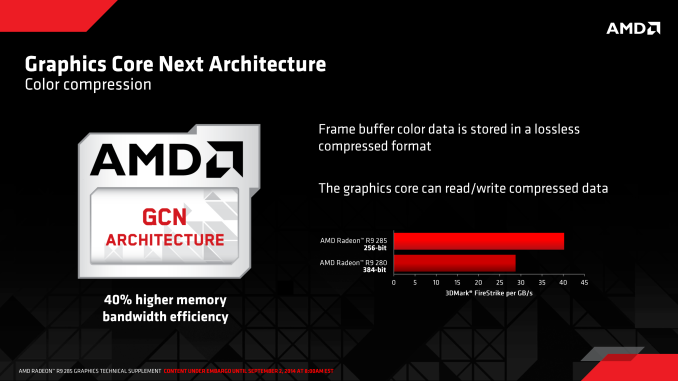
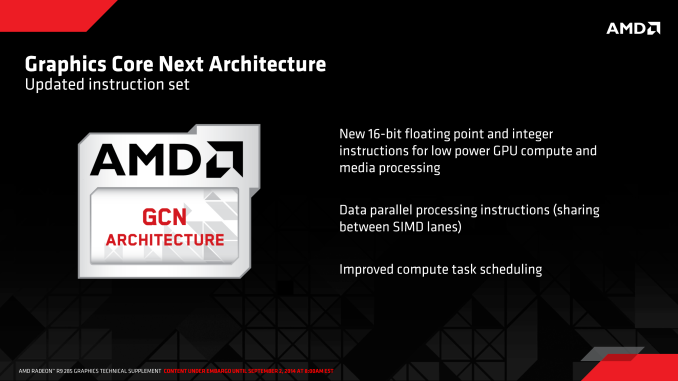
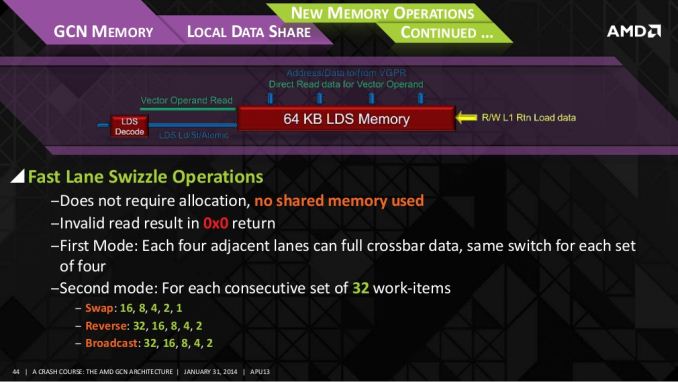
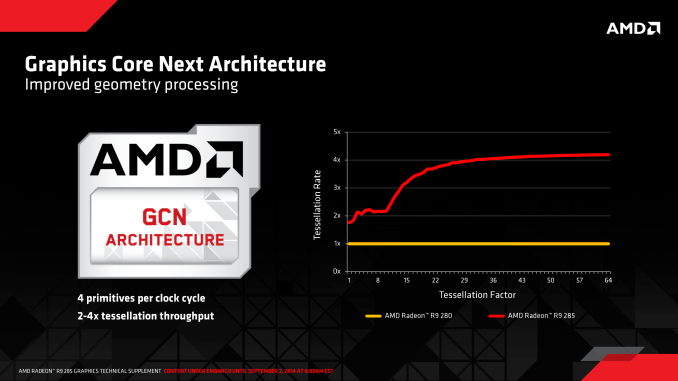
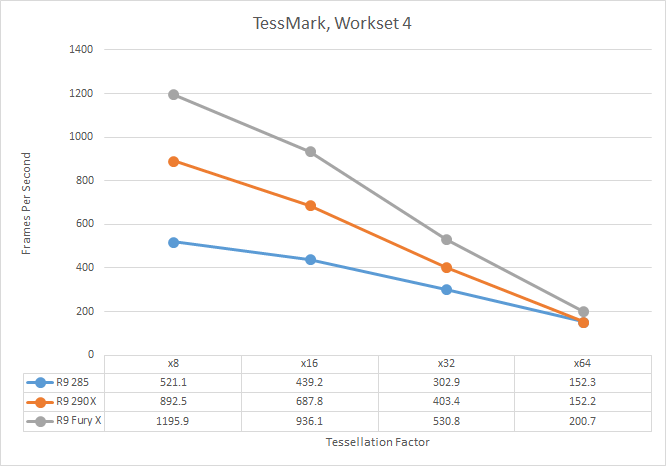








458 Comments
View All Comments
nandnandnand - Thursday, July 2, 2015 - link
"Depending on what you want to believe the name is either a throwback to AMD’s pre-Radeon (late 1990s) video card lineup, the ATI Rage Fury family. Alternatively, in Greek mythology the Furies were deities of vengeance who had an interesting relationship with the Greek Titans that is completely unsuitable for publication in an all-ages technical magazine, and as such the Fury name may be a dig at NVIDIA’s Titan branding."Alright, that's pretty funny.
Moonshot - Thursday, July 2, 2015 - link
Took you guys a while to get this review out, but now I can see why. It's very detailed. Though I am not impressed with the card itself, it is a decent effort by AMD, but the product feels unfinished, almost beta quality. No HDMI 2.0 is also a big downer, along with "only" 4GB" RAM.Read more at:
https://moonshot.re
Glenwing - Thursday, July 2, 2015 - link
Great review :) Been waiting eagerly for it, Anandtech as always is so much more detailed than other reviews.In case you're interested though, I did pick out a few minor typos ;) Page numbers going by the URLs...
Page 11: "while they do not have a high-profile supercomputer to draw a name form"
Page 14: "and still holds “most punishing shooter” title in our benchmark suite" probably should be "holds the"
Page 19: The middle chart is labeled "Medum Quality"
Page 25: "AMD is either not exposing voltages in their drivers or our existing tools [...] does not know how to read the data"
Page 26: "True overclocking is going to have to involve BIOS modding, a risker and warranty-voiding strategy"
Page 27: "the R9 Fury X does have some advantages, that at least in comparing reference cards to reference cards, NVIDIA cannot touch" very minor, but I believe the comma should be after "that" rather than "advantages"
Page 27: "it is also $100 cheaper, and a more traditional air-cooled card design as well" I believe should be either "and has a [...] card design" or "and is a [...] card"
Cheers :) Sorry if I seem nitpicky. If anything, it means I read every word :P
Ryan Smith - Thursday, July 2, 2015 - link
"Sorry if I seem nitpicky."There is no need to apologize. Thank you for pointing those out. They have been fixed.
chizow - Thursday, July 2, 2015 - link
Ryan, on the Mantle discussion page:"Mantle is essentially depreciated at this point, and while AMD isn’t going out of their way to break backwards compatibility they aren’t going to put resources into helping it either. The experiment that is Mantle has come to an end."
"Depreciated" should probably be deprecated when referring to software that still technically works but is no longer supported or recommended. Good discussion nonetheless, that paints a clearer picture of the current status of Mantle as well as some of the fine tuning that needed to be done per GPU/arch.
Also, just wondering, if you still feel AMD launched and performed the run-up of Fury X exactly as they planned, it does sound like you're more in agreement with me that 980Ti really caught them off guard and changed their plans for the worse.
5150Joker - Thursday, July 2, 2015 - link
Good review and for those that called [H] review's somehow biased, well here's AT where the Fury X again get's its ass handed to it by 980 Ti and Titan X.meacupla - Thursday, July 2, 2015 - link
Yeah, this seems to be just an architectural problem. Fury X is properly faster than 290X, but I guess you can only polish a turd so much.8.9 billion transistors on Fury X vs. 8 billion on 980 Ti. 980Ti is not even using all of those and it's still faster.
mchart - Thursday, July 2, 2015 - link
The problem is that a ton of those transistors are used for the memory with the Fury. With the same amount of ROPs the Fury X is just really held back.I think once they have access to a die shrink and can increase the ROPS and tweak some things what they have with Fiji will be a monster. Because of their lack of resources compared to NVidia they couldn't sit around and do what NVidia is doing, and instead had to just spend their money designing something that will work better once they have the smaller process available.
Innokentij - Friday, July 3, 2015 - link
You need to be mad to think hardocp is not a legit review site where they show u all the numbers u need to know and the time frame. I must admit i added a lot of people on the forums to biased and not worth to pay attention to cause of the bashing of that site.Michael Bay - Saturday, July 4, 2015 - link
Nobody cares about what u have to admit, lunatic.